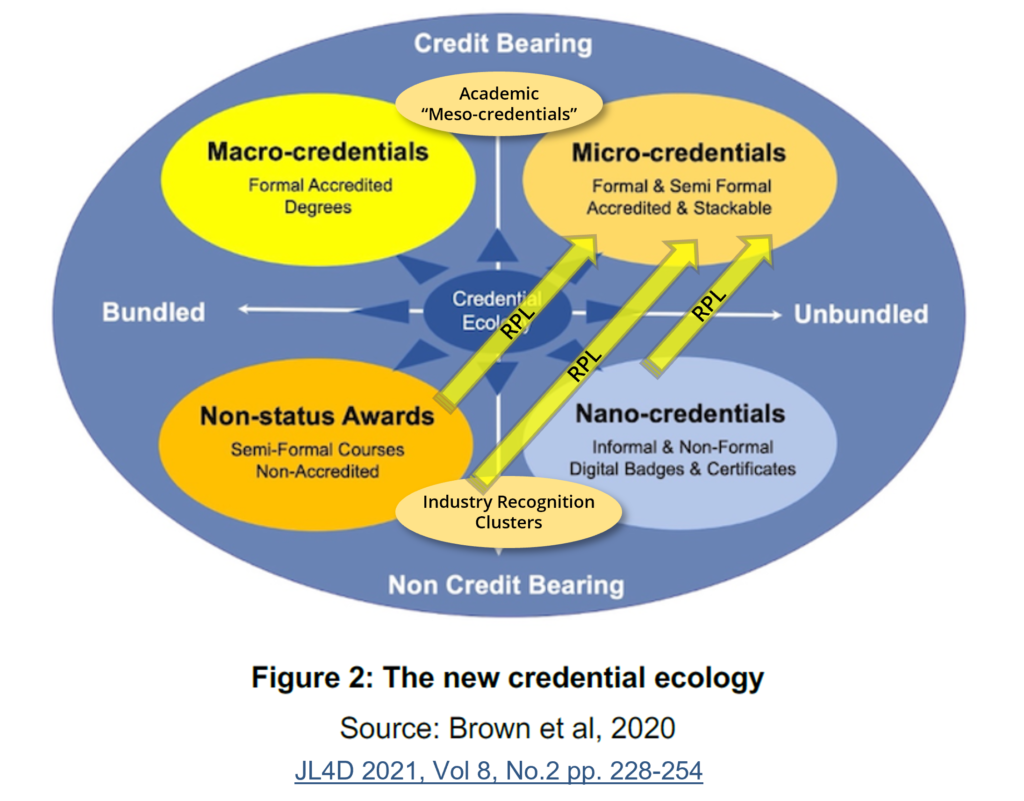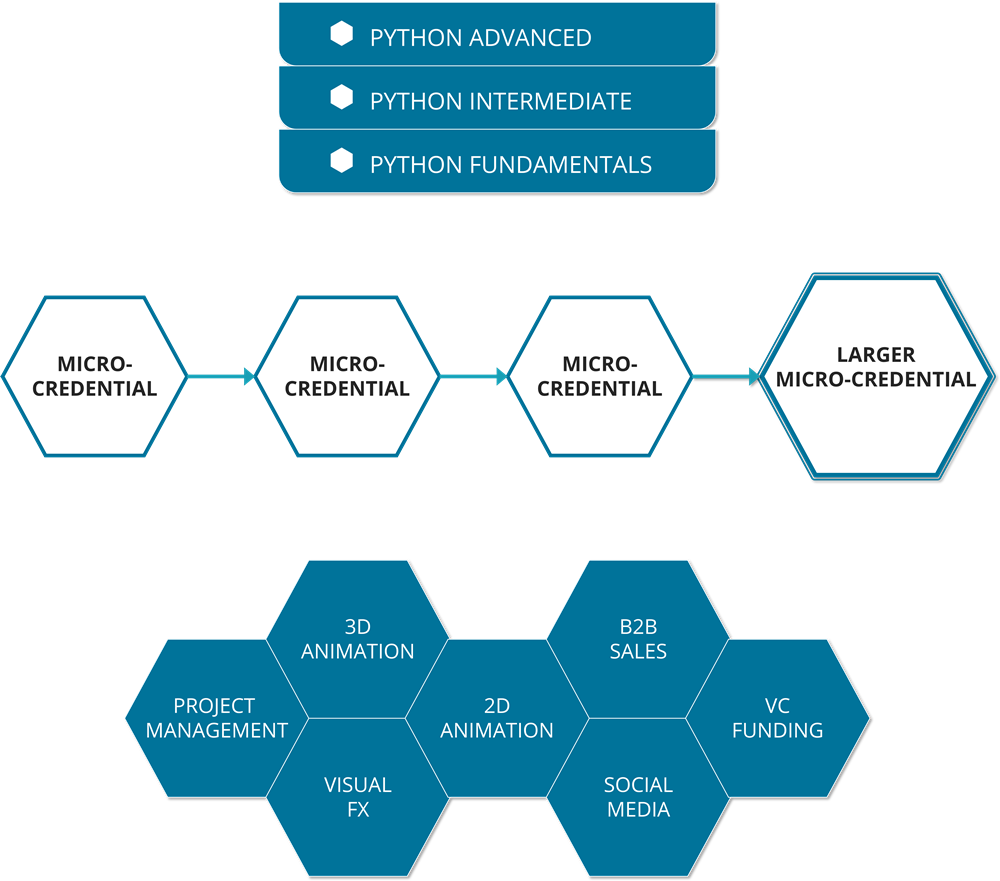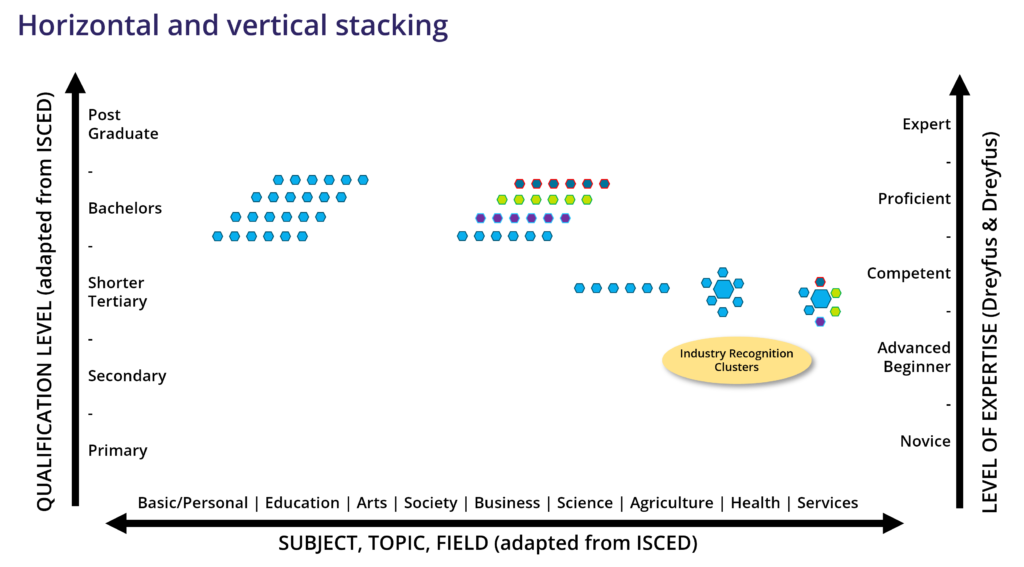Part of “Scenes from a MOOC” – excerpts from an orphaned video-centric MOOC about micro-credentials based on Open Badges (as most are..)
I often say to people that stacking micro-credentials is one of those things that sound great, but can come with unwanted baggage, can lead to unintended consequences and generally complicate things that were supposed to be simple.
Stacking for what?
l’ll start the discussion with this useful diagram from Brown et al in the Journal of Learning for Development (J4LD). The authors developed a model for a credential ecology that I’ve fiddled with a bit, leaning on the CC BY licence.

The Global Micro-Credential Landscape: Charting a New Credential Ecology for Lifelong Learning.
The diagram maps different kinds of credentials across 2 axes:
- The vertical axis is about formality, or credit versus non-credit.
- The horizontal axis is about credential “bundling”, or aggregation
In the top two quadrants related to credit, diplomas and degrees are called macro-credentials that can be stacked from individual micro-credentials. I’ve added the notion of “meso-credentials” of intermediate sizes in the centre. The bottom two quadrants are focused on industry recognition. The terms provided by the authors aren’t widely used – I’ll just call these non-credit micro-credentials
A new element added by the research team is the concept of transforming non-credit to credit via the Recognition of Prior Learning or RPL. This is what they call the “diagonal axis” and I’ve added diagonal yellow arrows to illustrate. RPL is normally done at the institutional level, based on internal policies, using evidence portfolios and other methods of assessment. Within the institution, it’s usually possible to carry forward the valuation of an external nonformal credential, in the same way that an external academic credit only needs to be evaluated once for credit transfer. There are some initiatives in early development in Canada, Australia and perhaps elsewhere, to build this into a more system-wide approach, using terminology such as “”external credit bank” or “micro-credentials marketplace.”
Horizontal and vertical stacking

Stacking of micro-credentials is often described as vertical or horizontal. Vertical stacking, also called laddering, usually means that one credential builds on top of another, leveling up as in this Python example. However, leveling up within a skill is not as common as the notion of sequential pathways.
Sequential or linear pathways are programs of learning that have been pre-designed with micro-credentials as signposts on the way. They might include a range of topics and activities, but everything been built into a program plan.
Horizontal stacking is defined as broadening knowledge across multiple topics at a similar level, or perhaps specializations within a topic area. In this example, a creative technology skillset is being broadened with operational and business skills. Horizontal stacking is usually more learner centric than vertical stacking: educators and often learners can swap elements in and out to build more custom solutions.
This very popular and useful image from Bryan Mathers is another take on the various kinds of stacking and pathways:

The Stepping Stones model is the one I was just describing: sequential pathways, or linear progressions. They are prescriptive, programmed in advance. This is often the default for an instructional designer. It might be a certificate program in Continuing Education, for example. But this doesn’t have to be the only model.
The Collection model is still prescriptive, but the order doesn’t matter: program requirements are met once enough micro-credentials have been earned, or “collected”. Collections can actually be more flexible than than the preset pie form you see here: think of a honeycomb or a small, multi-cell organism that can add horizontal options organically.
The Constellation is a very popular metaphor that is non-linear AND descriptive. As Rebecca Solnit says:
“The stars we are given. The constellations we make. That is to say, stars exist in the cosmos, but constellations are the imaginary lines we draw between them, the readings we give the sky, the stories we tell.”
So a constellation is human construct: it’s a way of finding patterns, connections and stories among a scattering of stars or a collection of skills and achievements.A constellation can be a way of looking back and making sense of what you’ve already done, as in a portfolio for the Recognition of Prior Learning.Or it can be a way of looking forward at what you might do next, based on what you’ve already done, as in a smart learning ecosystem. This is the most learner-centric and even learner empowered model for pathways.
Dreaming big about stacking
The words horizontal and vertical imply a grid, where the horizontal axis could express the breadth of topics and the vertical axis could express the levels of learning:

I’ve actually provided two vertical axes here. The one on the left displays education qualification levels. Over on the right, I’ve added a popular model for leveling up skills in the context of work that’s mentioned in the Australian National Microcredentials Framework.
As an educator, if your thinking naturally leans toward stacking micro-credentials for credit, then it can be exciting to imagine modular educational pathways for Bachelors degrees for example, where students could complete programs in bite-sized chunks, stepping on and stepping off the “qualifications trolley”, and being recognized for even partial completion of larger qualifications.
Some initiatives are even exploring the feasibility of supporting “build-your-own degrees”, where lifelong learners of all kinds would be able to custom assemble credentials from multiple institutions, based on a common currency for micro-credentials. So in theory, the modularization of credentialing through micro-credentials could take the practice of Credit Articulation and Transfer to an entirely new level.
In practice, we’re not there yet, and it can be very difficult to innovate at the core of established credentialing systems, where the stakes are very high and practices are firmly established. Some objections that have been raised for this vision of stacking credits include:
- Lack of awareness and trust between institutions. Micro-credentials do not magically remove structural and cultural barriers to mobility.
- Most academic macro-credentials are not “build your own degree”, they are built on specific programs of study, usually within a single institution. A micro-credential may be worth x credits, but only if it can be applied to a program. There are actually very good reasons for having integrated programs that describe a learning arc.
- And finally, academic stacking doesn’t solve the problem that micro-credentials were invented to solve, which is to provide more agile and authentic ways to develop and recognize skills. A focus on credit slows things down, comes with baggage and pushes us back to old ways of thinking. And Employers usually say they’re not interested in the credit value of micro-credentials, they are interested in their practical value in the workplace. From an employer perspective, credit may be nothing more than a proxy for quality, that can also be delivered by institutional brand.
Let’s remember that Open Badges were originally invented to recognize and share learning and achievement everywhere. Micro-credentials have emerged as a more formal subset of Open Badges, focused on agile education for workplace skills. But the idea was to supplement, enhance and fill gaps in formal learning, not to replace the entire damn system.
Institutions don’t need to totally reinvent themselves to start reaping the benefits from micro-credentials: innovation can begin at the edges, in Continuing Education, Extension programs, Adult Education, even in Contract Training. Value and quality can be balanced with agility by a “credit ready” approach, where micro-credentials are developed and documented according to standardized processes that can be confirmed for credit later.
This means starting with smaller initiatives and programs more related to workplace-relevant expertise than academic qualifications. And smaller stacks that have immediate practical value. Then maybe think about stacking further, but also think about unifying, transformative elements to bring these things together, that go beyond building a Bachelors like Lego.
